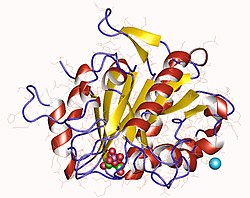6-Phosphogluconolactonase
| 6-Phosphogluconolactonase | ||
|---|---|---|
 | ||
| 6-Phosphogluconolactonase monomer, Trypanosoma brucei nach PDB 3E7F --> | ||
| Eigenschaften des menschlichen Proteins | ||
| Masse/Länge Primärstruktur | 258 Aminosäuren | |
| Bezeichner | ||
| Gen-Namen | PGLS ; 6PGL | |
| Externe IDs |
| |
| Enzymklassifikation | ||
| EC, Kategorie | 3.1.1.31, Hydrolase | |
| Reaktionsart | Hydrolyse | |
| Substrat | 6-Phosphogluconolacton + H2O | |
| Produkte | 6-Phosphogluconat | |
| Vorkommen | ||
| Homologie-Familie | Phosphogluconolactonase | |
| Übergeordnetes Taxon | Lebewesen | |
6-Phosphogluconolactonase (6PGL) (Gen: PGLS) ist das Enzym, das 6-Phosphogluconolacton zu 6-Phosphogluconat hydrolysiert. Diese Reaktion ist der zweite Teilschritt im Pentosephosphatweg. 6PGL kommt in den meisten Lebewesen vor.[1]
Die Expression der 6PGL ist erhöht in Brustkrebszellen, wie eine Proteomics-Studie zeigen konnte.[2]
Katalysierte Reaktion
 + H2O
+ H2O 
6-Phosphogluconolacton wird zu 6-Phosphogluconat hydrolysiert. Obwohl das Lacton von selbst hydrolysiert, hat es eine gewisse Stabilität, so dass es während seiner Lebenszeit unerwünschte Reaktionen eingehen könnte. Dem wird durch die 6PGL abgeholfen.[3]
Weblinks
Wikibooks: Biochemie und Pathobiochemie: Hexosemonophosphatweg – Lern- und Lehrmaterialien
- reactome.org: D-glucono-1,5-lactone 6-phosphate + H2O ⇒ 6-phospho-D-gluconate
Einzelnachweise
- ↑ UniProt O95336
- ↑ Ou K, Yu K, Kesuma D, et al: Novel breast cancer biomarkers identified by integrative proteomic and gene expression mapping. In: J. Proteome Res. 7. Jahrgang, Nr. 4, April 2008, S. 1518–28, doi:10.1021/pr700820g, PMID 18318472.
- ↑ Miclet E, Stoven V, Michels PA, Opperdoes FR, Lallemand JY, Duffieux F: NMR spectroscopic analysis of the first two steps of the pentose-phosphate pathway elucidates the role of 6-phosphogluconolactonase. In: J. Biol. Chem. 276. Jahrgang, Nr. 37, September 2001, S. 34840–6, doi:10.1074/jbc.M105174200, PMID 11457850.










